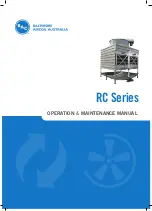
English
English
43/160
Clean the work area and remove all obstacles that may
cause accidents. Check the work area when going to
work and remove all items that could become entangled
in the cutting tool. Also remove all the objects that the
cutting tool can violently eject in the operation.
Do not allow anyone to enter the work perimeter. This
work perimeter must be 15 meters and is a danger
zone.
Never leave this machine unattended.
Be careful not to touch the hot parts of the
machine while the engine is running or
after use, such as exhaust, spark plug or high voltage
cables.
Do not use other accessories this machine except
those recommended by our company since its use
could cause severe damage to the user, people close
to the machine and the machine itself.
Always follow the safety rules given in this manual.
7.1. HOLDING AND GUIDING THE MACHINE
While working always place
yourself behind the machine and
hold it firmly with both hands on
the handles.
Warning! Do not use this rotary tiller with one
hand.
Warning! This rotary tiller could bounce upwards
or jump forwards unexpectedly. If the teeth hit
something hard that is buried in the ground such as
large stones, roots or trunks, if the soil is too hard or
if the ground is frozen. Always firmly hold the machine
with both hands.
This machine clutch is deactivated (disengaged)
by default, to activate the clutch and for the engine
power to transmit to milling cutters, the clutch lever
must be tightened.
The clutch lever has a security block that avoids the
accidental clutching of the machine.
To act on the clutch we firstly must remove the
security blockage moving with one finger the blocking
device (w1) downwards and without letting go,
pressing the clutch lever (w2).
7.2. WORKING WITH THE ROTARY TILLER
Start the machine following the instructions in the
manual.
Milling cutters in motion will pull the machine forward,
you must maintain the appropriate speed more or less
by nailing the spur in the soil.
Slowly move the tiller at the right rhythm so the milling
cutters have time go crumbling the land.
If the tiller sinks and doesn’t go, move the handlebar
left and right until it is released.
When working on slopes it is always slightly more
above the slope so that the machine is always below
you.
W1
W2
Summary of Contents for MULE 561 QG
Page 53: ...English 53 160 NOTES...
Page 133: ...133 160 2 2 1 2 2 15...
Page 134: ...134 160 2 2 1 2 2 2 Raynaud...
Page 135: ...135 160 2 3 15 2 4...
Page 136: ...136 160 2 5...
Page 137: ...137 160 2 6...
Page 138: ...138 160 3 0 6 20W 40 CE EU Lwa dB A XX...
Page 139: ...139 160 4 STOP OIL STOP O...
Page 140: ...140 160 5 2 1 2 3 4 5 6 7 8 9 10 11 12 13 5 5 1 8 8 10 1 11 12 13 2 3 4 5 6 7 11...
Page 142: ...142 160 6 6 1 1 2 3 4 5 6 7 6 2 6 2 1 H T5 T4 6 2 2 w1 W2 W1 W2 T4 T5 H 1 2 4 5 6 7 3...
Page 143: ...143 160 W3 W5 W4 6 2 3 H 6 3 1 2 3 L W4 W5 W3 H H...
Page 144: ...144 160 3 6 3 1 4 20w 40 0 6l OIL 0 6l 1 OIL MIN MAX...
Page 145: ...145 160 6 4 6 4 1 Garland 6 4 1 1 OFF 6 4 2 6 4 2 1 STOP...
Page 146: ...146 160 6 4 2 2 STOP 6 4 3 7 10 10 20 STOP...
Page 147: ...147 160 15 7 1 W1 W1 W2 7 2 W1 W2...
Page 148: ...148 160 7 2 1 15 20 cm 2 8 8 1 8 1 1...
Page 149: ...149 160 8 1 2 8 1 3 8 1 4 8 2...
Page 150: ...150 160 8 2 1 8 2 2 Y2 Garland ref 7199000020 Gar land Y1 Y1 Y2 2 25 50...
Page 151: ...151 160 a Y1 Garland REF 7199000020 b Y2 Y1 Y2 0 4l 1 8 2 3 0 6 0 7 mm 8 2 4...
Page 152: ...152 160 9 Off I...
Page 153: ...153 160...
Page 154: ...154 160 10 5 11 5 0 C 45 C 12...
Page 155: ...155 160 13 1 1999 44 2 13 2 Garland Garland Garland 13 3 H Garland 13 4 13...
Page 157: ...157 160 NOTES...
Page 158: ...158 160 NOTES...
Page 160: ......
















































